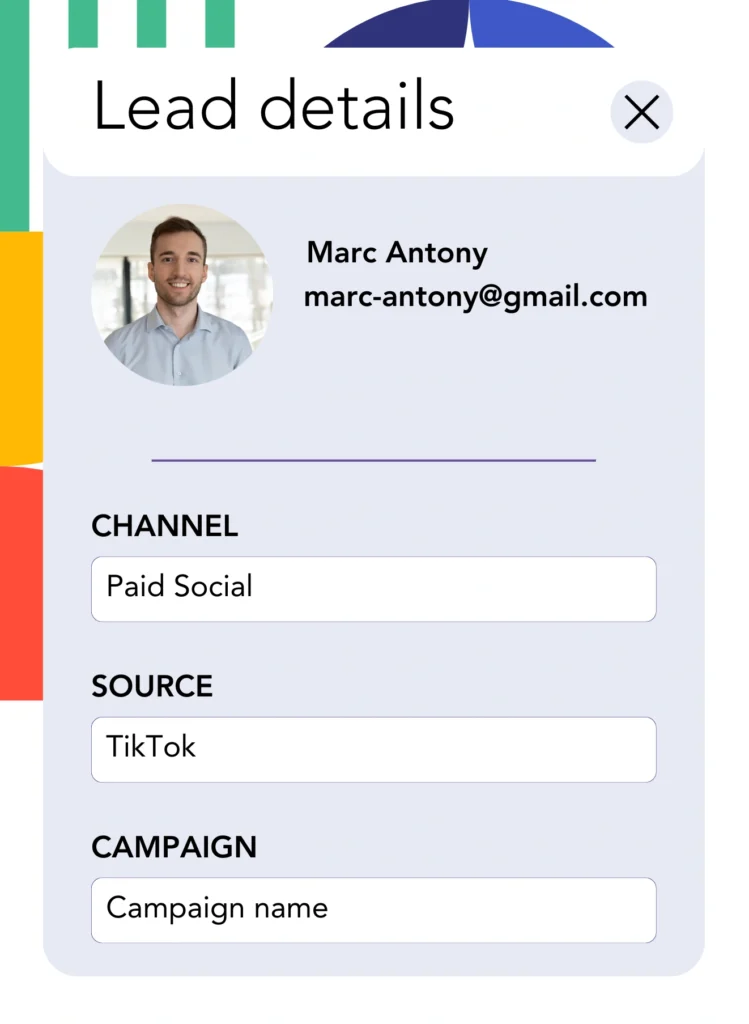You acquire leads on TikTok and transfer them to Close CRM. But matching each lead to a TikTok ad isn’t possible.
Even after a lead converts into a customer, you cannot bind that customer to the TikTok ad that brought them in.
Not being able to track your TikTok ads makes performance assessment impossible. As a result, you’re spending on numerous ads without clarity on which bring in results.
Luckily, a simple solution is available to track each lead back to the specific TikTok campaign, ad group, and ad responsible for it.
We’ll move through it one step at a time!
How to capture TikTok ads in Close CRM
Step 1: Add Leadsources in the head tag of your website

Leadsources is an easy-to-use tool that tracks lead sources on your website. Once integrated, it records up to 7 lead source details for each lead generated.
Sign up to Leadsources.io – it’s free.
Insert the Leadsources tracking code into the head tag of your website – follow this guide.
Step 2: Add the UTM parameters to your TikTok ads

In your URL, use UTM parameters—campaign, ad group, and ad—to track TikTok ads performance.
You can insert the following UTM parameters:
- UTM_medium=paidsocial
- UTM_source=tiktok
- UTM_campaign=campaign-name
- UTM_term=ad-group-name
- UTM_content=ad-name
Your finalized URL will look like this:
https://www.yoursite.com/?UTM_medium=paidsocial&UTM_source=tiktok&UTM_campaign=campaign-name&UTM_term=ad-group-name&UTM_content=ad-nameNote: Leadsources gathers all lead source details, such as channel, landing page, and subfolder, even when UTM parameters are not present, ensuring complete tracking for each lead.
Step 3: Add the hidden fields in your form

Your form’s hidden fields contain the lead source data that Leadsources captures.
Upon the submission of your form by a new lead, Leadsources fills the hidden fields with TikTok ads data.
For specific steps on how to add hidden fields in your form, consult this guide.
Step 4: Capture the TikTok ads data in Close CRM

When users engage with your ads and land on your website, Leadsources gathers the TikTok ads data, including campaign, ad group, and ad.
Leadsources automatically inputs the TikTok ads data into the hidden fields of your form.
When the form is submitted, you can consistently forward TikTok ads data and your leads to Close CRM by configuring your form to work with Close CRM.
How does Leadsources work?
Each time a visitor accesses your site, Leadsources records the relevant TikTok ads data.
This TikTok ads information is captured in the hidden fields of your form. Upon form submission, it is sent to Close CRM, along with the lead details (name, email, etc.).
For each visitor, the data detailed below is logged by Leadsources:
- Channel
- Source
- Campaign
- Content
- Term
- Landing page
- Landing page subfolder
Without UTM parameters, Leadsources effectively utilizes the referrer for tracking lead source data.
There are cases where UTM parameters cannot be used, particularly when traffic is sourced from organic channels:
- Google Search
- Instagram bio link
- Social media posts
- Etc.
In such situations, numerous lead source tracking tools cannot determine lead sources, as they rely entirely on UTM parameters. However, Leadsources manages to capture specific lead source information, even when UTM parameters are absent:
- Channel
- Source
- Landing page
- Landing page subfolder
Therefore, unlike many lead tracking tools, Leadsources ensures complete lead data tracking across every available channel:
- Organic Search
- Paid Search
- Organic Social
- Paid Social
- Referral
- Affiliate
- Display Advertising
- Direct Traffic
Moreover, Leadsources efficiently organizes your traffic by channel, leading to a clean and concise dataset.
In short, Leadsources is an efficient and simple tool that consolidates comprehensive lead source data across all channels in a centralized location.
Performance reports: Lead, sales, and revenue by source
When you track TikTok ads data in Close CRM, you can develop a selection of performance reports, such as:
- Leads, sales, and revenue by channel
- Leads, sales, and revenue by source
- Leads, sales, and revenue by campaign (aka. Tiktok campaign)
- Leads, sales, and revenue by term (aka. Tiktok ad group)
- Leads, sales, and revenue by content (aka. TikTok ad)
- Leads, sales, and revenue by landing page
- Leads, sales, and revenue by landing page subfolder
As a result, you can strategically adjust your TikTok budget based on the campaign, ad group, and ad that contribute to your leads, sales, and revenue.
Let’s examine the different lead performance reports that can be derived from this data.
1. Lead source reports
Produce performance reports that present the total leads generated by:
- Channel
- Source
- Campaign
- Term (aka. TikTok ad group)
- Content (aka. TikTok ad)
- Landing page
- Landing page subfolder
Example #1: Leads by channel
This report clarifies which channel is most productive in terms of lead generation.

Example #2: Leads by TikTok campaign
At this point, you can target a specific lead source (e.g., TikTok) and measure the effectiveness of each TikTok campaign in generating leads.

Example #3: Leads by TikTok ad
After recognizing the TikTok campaign that results in the highest number of leads, you can explore which particular ad group or ad is driving that success.

2. Sales and revenue source reports
Now that we know the TikTok campaign, ad group, and ad that yield our leads, we should examine whether these leads are driving sales and revenue.
We need to determine which leads become paying customers. This can be done by integrating your leads with a CRM like Close CRM, allowing for tracking of sales and revenue from various channels, sources, TikTok campaigns, ad groups, ads, landing pages, and more.
As a result, you can reshape your TikTok ads strategy to target the channels, sources, campaigns, ad groups, and ads that maximize sales and revenue.
Also, you can produce a variety of sales and revenue reports, such as:
- Sales and revenue by source
- Sales and revenue by campaign
- Sales and revenue by term (aka. TikTok ad group)
- Sales and revenue by content (aka. TikTok ad)
- Sales and revenue by landing page
- Sales and revenue by landing page subfolder
To provide clarity, let’s explore the following scenario:
| Channels | Search Paid | Social Paid |
| Leads | 50 | 75 |
| Sales | 5 | 6 |
| Average order value | $150 | $100 |
| Revenue | $750 | $600 |
Following the launch of advertising on Google and TikTok, the first “Leads by Channel” report revealed that Social Paid ads (TikTok) attracted a higher number of leads than Search Paid ads.
Yet, after exporting your sales and revenue data from the CRM, you discovered that the Search Paid channel was generating higher revenue with a reduced number of leads than the Social Paid channel. As a result, you chose to increase the budget for the Search Paid channel.
LeadSources tracks the source of each lead in Close CRM, whether they come from ads, organic search, social, email, etc. and syncs that data with each submission. See the full breakdown on the lead source in Close CRM page.

